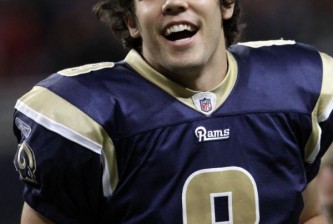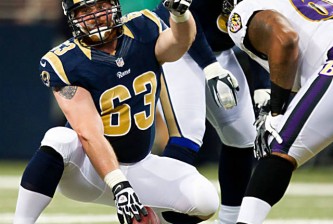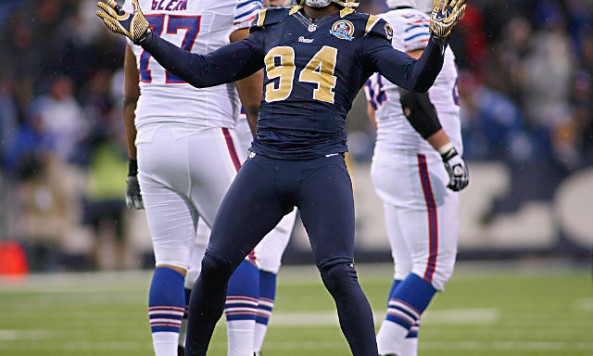The Rams will face a formidable test vs the Atlanta Falcons, who have one of the best records at home in the NFL. Since Mike Smith took over as head coach, the Falcons have a 33-7 record at home. Even more impressively, reports Falcons correspondent Knox Bardeen, they are 17-3 following a loss in that same span of time. So if you're playing probability tables, the Rams have somewhere between a 15 and 18% chance of winning this game.
However, this game is about matchups and there are a few things the Rams can do to move the odds more in their favor.
1. Get Immediate Pressure in Ryan's Face
Matt Ryan is the definition of ruthless efficiency at quarterback. He has a live arm, but not a Joe Flacco cannon arm. He is functionally mobile, but not Colin Kaepernick hold-on-to-your-panties mobile. Where he wins is with field vision and anticipation and lethal accuracy. Oh, and his receivers are pretty good too (*cough*).
That made his struggles against the New Orleans Saints (one game removed from having THE WORST DEFENSE IN NFL HISTORY) all the more notable. Matt Ryan was jumpy and inaccurate for solid stretches of the game, handicapping their offense and scuttling scoring chances.
However, with the game on the line, the Falcons went into hurry-up and Ryan looked like his old self, shredding the Saints defense … until they got inside the ten yard line. I went to the All-22 film to see what I could make of his Jeckyll and Hyde performance, and this is what I saw:
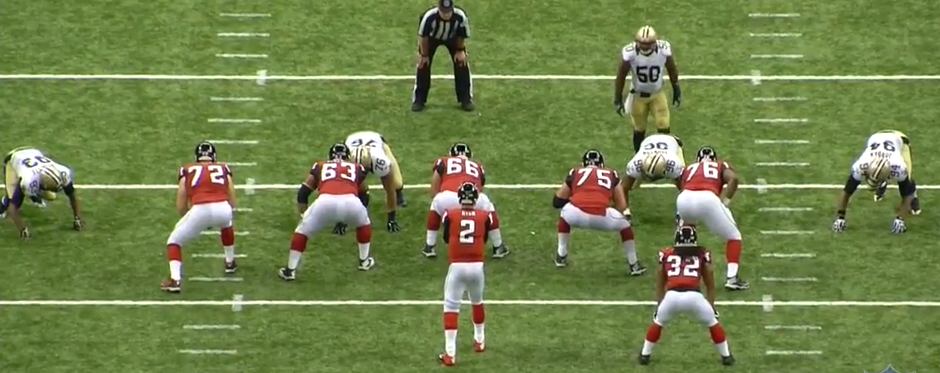
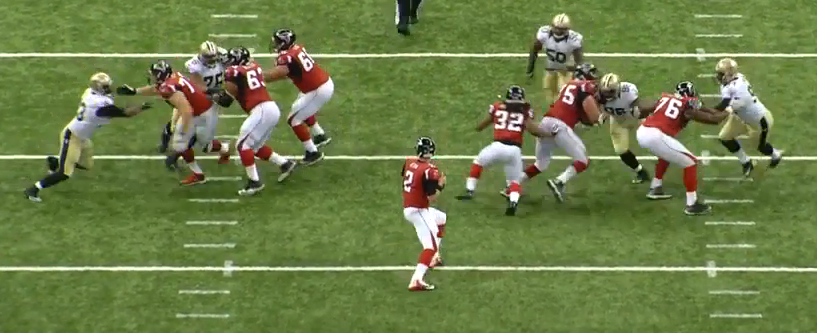
When Ryan drops back from center, he keeps his eyes straight downfield, able to use his peripheral vision to see his receivers on both sides of the field. This makes him very difficult for secondaries to read, and allows him to quickly find the best available play.
If a four-man defensive front is widely aligned and rushes the lanes outside the center, it only helps Ryan see the field. This pair of screencaps shows Ryan's dropback before hitting Harry Douglas for a 20-yard gain to the New Orleans 7 yard line. The middle linebacker (50) lines up offset, and his stunt will arrive much too late to disrupt Ryan's vision or throw.
However, on plays where the pass rush crosses Ryan's face during his dropback, he turns his head and chooses a side, cutting off half the field. It seemingly also introduces a little panic into his feet, as his offensive line — in steady decline since the loss of line coach Paul Boudreau — is not very good, particularly on the edges.
Moreover, even the threat of obscuring his dropback vision can be enough to force Ryan out of his comfort zone. The play right before that 20-yard completion, here is how the defensive aligned.
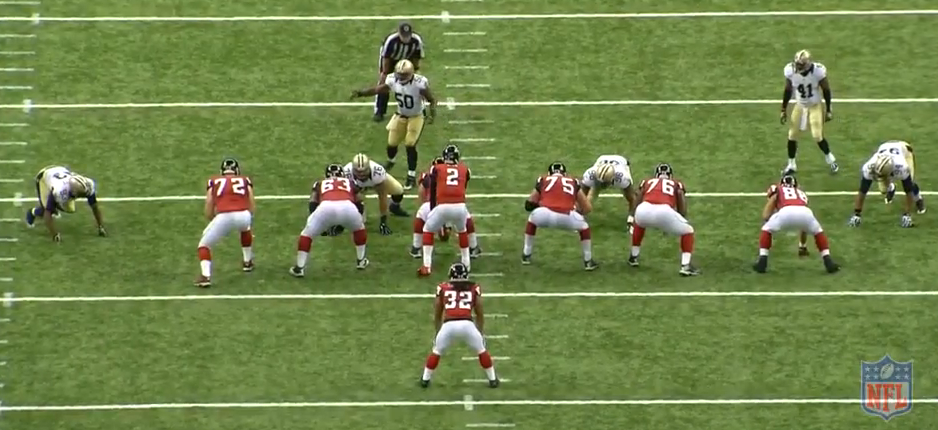
When this play started, Ryan was in shotgun with Jacquizz Rodgers offset, but Ryan apparently didn't like how the DT and MLB were lined up in his field of vision, so he walked up and changed the play. He shifted his line, moved Jacquizz, and handed off to him. The play was stuffed for no gain.
To give Ryan credit, he doesn't turn into Blaine Gabbert with a little upfront pressure. But rather than hang in for the big play, he will typically attempt to escape and choose lesser plays. The Rams' "bend but don't break" defense depends on forcing quarterbacks to choose lesser plays to keep the score close.
This pattern of behavior showed up time and again, suggesting that it might be Michael Brockers and James Laurinaitis, more than Robert Quinn and Chris Long, who determine the Rams' defensive effectiveness vs the Falcons. (If I'm the Falcons, I counter by sending as many receivers into Laurinaitis' zone as I can, and keep him moving backward rather than forward. That, and pray Peter Konz can hold up against Brockers.)
2. Bradford needs to take what the defense gives him
Drew Brees is not a man to change what he does based on the talent on the other side of the field. Brees will throw at anyone at any time if he sees his receiver is singled up. This got him into trouble more than a few times vs the Falcons' talented rookie cornerbacks Robert Alford and Desmond Trufant. Both made multiple very good plays outside the numbers to deny downfield passes.
If you had Tom Brady's offensive line, you could probably attack these corners' aggressive tendencies with double moves and wait for your guys to come open. Sam Bradford does not have that kind of protection, though.
The good news is that the middle of the field was wide open for Brees all day long. The Falcons outside linebackers are nearly helpless when you ask them to turn and run with a slot receiver. Brees completed 9 of 13 passes to interior receivers Jimmy Graham and Marques Colston for 113 yards and 2 TDs.
Moreover, the Saints' aggressive vertical routes left wide open spaces for underneath throws to Darren Sproles and Pierre Thomas. Brees connected on 10 of 10 passes for 104 yards to his running backs against this defense.
Against the Cardinals in Week 1, Bradford rarely uncorked the deep ball as Chris Givens was nearly swallowed by Patrick Peterson in man coverage. However, the downfield threat of Givens still worked to stretch the defense and open up opportunities elsewhere for Jared Cook and Tavon Austin, giving Bradford ample opportunity to simply distribute the ball to the open man. If Bradford can continue this good play, the Rams offense should be able to keep the chains moving.
3. The Rams OL needs to master the silent count
SI writer Mark Bowden wrote a fantastic feature on longtime offensive line coach Howard Mudd, the inventor and perfector of the silent count as a way of nullifying crowd noise. It was a concept that he had toyed with since his time with the Bernie Kosar-era Miami Hurricanes, but had never fully implemented until working with a rookie quarterback named Peyton Manning, and second-year tackle Tarik Glenn.
A first-round draft pick in 1997, Glenn spent his first year discovering that blocking NFL defensive ends was hard under ordinary circumstances, but when he couldn't hear, it was nearly impossible. Manning arrived the following year and was understandably frustrated when defensive ends kept hitting him like freight trains from his blind side. Mudd remembers hearing the quarterback chew out Glenn on the sideline during one game and stepping up to defend his tackle. "Tarik can't hear you," Mudd told Manning.
"Well, he should be able to hear," Manning complained. "It's not that loud."
"That's bull—-," Mudd said.
"Well, [tackle Adam] Meadows can hear!"
"You are not in charge of deciding what Tarik can hear and what he can't hear!" Mudd told him.
While the Rams continue to be one of the NFL's most-penalized teams, I believe the pre-snap penalties are among the most damaging. They are the equivalent of a free defensive timeout, and they often burn a play from the playbook. The realm of playcalling possibilities at 1st-and-10 is much more diverse than that of 1st- or 2nd-and-15.
Moreover, the Falcons were the least-penalized team in football last year. Their 68 penalties were less than half of the Rams' total of 148. They will not give up yards, which makes any deficit by the Rams more damaging.
At the bye week last season, the Rams OL had been flagged more than 30 other teams, with 14 false starts and 16 holding calls. Rodger Saffold has been the worst offender on the line in this respect. If he and Bradford can stay in sync, the Rams can avoid shooting themselves in the foot and make this a winnable game.
And a win on the road against a team of the Falcons' caliber isn't just a win. It would be a statement.




















